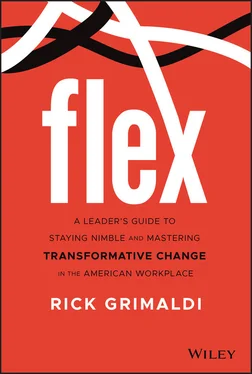For parents who are still hoping to send their student to college, the value proposition has changed, too. When they consider taking out a second mortgage on their home so their student can attend a top-tier university, they want to know that their child will be employable in a competitive industry. They want to know that university will graduate their child in four years instead of six because space in required courses is available.
Nontraditional students who do decide to pursue a college degree want to know that they are partnering with an educational institution that understands the challenges they face to make it to class every day. Many are juggling work commitments, a lengthy commute, or caregiving for parents to make their dream of a college degree a reality. They are hunting for flexibility.
In the same way, what will happen to blue-collar workers who have spent 30 years on the floor of a manufacturing facility doing unskilled work when the company retools into a high-tech environment? Will they face layoffs and be replaced with new college grads with an information technology degree?
Nontraditional students—older students considering retraining and younger students not completely sold on college—have no interest in a “well-rounded liberal arts degree.” Rather, they want to know there's a good return on investment for an actual employable skill set in exchange for their hard-earned dollars.
For just this reason, many nontraditional—and other—students will turn away from elite universities that seem out of touch in favor of pursuing online options or a degree from a trade school
There are 30 million jobs in America today that pay an average of $50,000 per year that don't require a degree from a four-year university. Despite the benefits and pensions these jobs offer, there's still a shortage of workers trained in such vocational schools. 11
And it's the same situation when it comes to community college.
In the past, students and their parents saw them as a steppingstone into a four-year university. But expect them to take a more central role in creative partnering with local employers in the years to come.
So, yes, education simply must reinvent itself at every level—from K to 12 and prestigious colleges to trade schools and community colleges—to keep pace with the needs of students, the needs of employers, and the needs of society itself. No longer can we allow urban inner-city schools to decay leaving impoverished students ill-equipped to meet the needs of employers in their communities. We need them.
Language Is Changing: R U Up to Speed?
Not only are demographics and education changing but also the way we communicate is changing. Much like cells in biological evolution, which are constantly mutating according to their environment, so too is language ever evolving.
Linguists study this phenomenon, 12 in fact, and talk about the concept of “drift,” the seeming random nature of how language changes over time, much like the concept of genetic drift in biology, which studies how existing genes vary in a population with random sampling. The idea here is that, whether we are talking about genes or language, you can study whether (and how) it survives and reproduces in the future.
When it comes to evolving language, it's typically a result of certain pressures that come to bear. Changing social norms, for example, signal which words are socially acceptable or not. Then there are technical innovations that make it more convenient to communicate within certain parameters.
Sometimes it's just the way that some verb conjugations are harder to remember than others, making some words used far less frequently until they fall out of our lexicon. When it comes to other words, they become favored by “insiders” or “outsiders” or are only used by those in power (such as corporate executives)—or those who feel disenfranchised (such as protesters).
As our world reshapes itself through changes in generational and racial demographics, the language we use—the way we communicate—is reshaping itself in some important ways. And it's critical to be aware and adept at navigating this change in the American workplace.
Communication Is Faster . . . For Better or for Worse
Humans have, of course, have been communicating over millennia. What's new, as we've just discussed, is the pace of change today with respect to language and communication.
Way back in 130,000 BCE, early people shared their experiences and documented primitive life via cave paintings through pigments made from fruit and berry juice.
Much later, about 1440, human communication took a giant leap forward with the invention of the Gutenberg printing press in France, giving rise to books and other written communication, while effectively standardizing spelling and punctuation.
As literacy grew, it became possible to pen a letter to a loved one and have it delivered by stagecoach and later by mail courier. In the 20th century, radio, newspapers, and television drove more innovation in language.
But think again about the pace of these innovations. Just 40 years ago—before the use of email became widespread in the 1990s—we expected to wait five days for a letter to reach someone across the country. Unless, of course, we paid for expedited delivery through FedEx or a similar service.
Xerox introduced fax machines as early as 1964, but they didn't really take off in corporate America until the late 1980s. And, although plenty of companies still use them, many are increasingly using Cloud-based fax services, which create images or PDF files to be sent over email. (And thank goodness for that. Nobody wants to sort through the pile of faxes on slippery paper at the office looking for the missing page as we once did.)
But the internet has changed all that. It's sped up communication even as it has forgone the importance of syntax in favor of a return to character-based communication. It is hard to ignore the irony of thousands of years of advances from cave paintings as a form of written communication to the use of the emoji today.
Although it's true that language has always been dynamic, with colloquialisms going in and out of vogue, this development is revolutionary throughout history. Texting means that you will receive a communication instantaneously with an instantaneous response expected.
So we've moved from books on a printing press to television to fax to email to texts . . . condensing the time frame of communication from years to weeks to days to immediately. And that is changing the world of work in some pretty surprising and unintentional ways.
One unfortunate side effect of the texting revolution—when texting is primary and email is a back-up communication solution—is that expectations of response time have ratcheted up alarmingly.
It's not uncommon for attorneys I know to get seven texts from a client or a colleague in a single hour they spend in a meeting or on a conference call. When those seven texts aren't answered within that 60-minute time frame, an email follow-up will arrive soon afterwards asking, “Did you get my text?”
As harried workers try to respond by text, email, and phone (while attending a videoconference on their watch), this has repercussions for the degree to which we are offering useful ideas with our divided focus at meetings or with clients.
If you're working on a complex task or trying to thoughtfully solve a difficult dilemma, you will likely be repeatedly interrupted by everyone from your spouse wanting to make dinner plans and the plumber you're trying to schedule, to clients and coworkers. The fact is: it's no longer okay to be “unreachable.”
One the one hand, the rapid pace of communication is a wonderful thing. In the face of globalization, it's made the world smaller. Our abbreviated texts and single-line emails are frequently an efficient and useful response to globalization in a busy world.
Читать дальше












